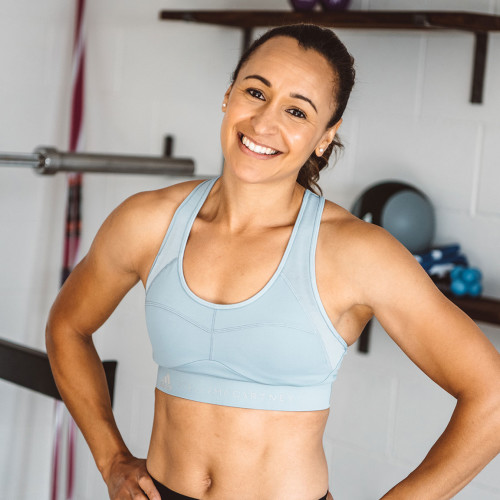What the heck is the Luteal Phase and what does it mean for my fitness?
2 years ago
Cycle syncing2 years ago
Cycle syncing
The Luteal Phase of your menstrual cycle is amazing for longer steady-state sessions and fat burning. Here’s how you can make the most of it with a little help from Jess Ennis-Hill and Jennis Physiologist, Dr Emma Ross...
Reviewed by: Dr Emma Ross
Are you pumped for that HIIT session one week, then you dread it the next? Is it easy to get that 5k PB some days, near impossible on others? Then Dr Emma Ross and Jess Ennis-Hill have some revelations for you, and they all centre around the Luteal (pronounced loo-tee-al) phase of your menstrual cycle...
The Luteal phase is the third phase in your menstrual cycle and takes place roughly between days 15-21. As you can see below, it follows The Follicular Phase (pronounced fuh-lick-yoo-lah) and precedes the Pre-Menstrual Phase.
3) The Luteal Phase
During the Luteal Phase, the hormone progesterone (pronounced: pruh·jeh·stuh·rown) hits its peak and oestrogen (pronounced: ee·struh·jn) is also high .
When it comes to how you feel in yourself: “One of the most widely reported effects of progesterone is that it has a calming effect,” says Dr Emma, “reducing anxiety and helping some women feel more chilled and more relaxed.”

The Luteal Phase of your cycle – and the hormonal changes that take place here – can have two very interesting effects on your workouts. The first is that you can work your muscles for longer before getting tired. “This means you might be able to go for longer sessions and build up greater endurance,” says Emma.
“The second interesting thing is that your body shifts your metabolism (the way you fuel your training) so that you burn fat more easily, which is good for longer, steady state exercise. This is different from the first half of your menstrual cycle, which is when your body prefers to use carbohydrates as its energy source for muscles.”
To take advantage of this fat-burning efficiency, Jess recommends including more Low Intensity Steady State workouts (LISS) into your sessions, which you can find in the Jennis app. Running, cycling, swimming and power yoga all count as LISS too.
The key is to select sessions “that keep you moving while maintaining your heart rate at a constant pace of about 50-70% of your max,” says Jess. “The idea is not to spike your heart rate up too much as you would with a HIIT session, say. A good rule of thumb is that you should still be able to hold a conversation.”
To take advantage of this fat-burning efficiency, Emma recommends including more LISS in your sessions
“When you’re in your Luteal Phase, you shouldn’t necessarily avoid all high intensity activity all together,” explains Jess. “But as a guiding principle, you should up the steady state. Your Jennis CycleMap will plot when to go steady, when to go hard and when to rest, which makes it easy to play to the strengths of this phase."
“By knowing the key characteristics of all the phases of your cycle,” says Dr Emma , “it can help you understand your levels of motivation, emotions and appetite, then map your fitness to reflect what’s happening.
"Take the Luteal Phase as an example. This is amazing for longer, steady state sessions and fat burning. By knowing when this is through Jennis CycleMapping , you’ll be able to do what’s best for your body and you’ll see fitness and motivation gains as a result.
“Most importantly for me, if you understand what’s driving your levels of motivation and recovery, you’re less likely to beat yourself up for not wanting to go hard on the HIIT or not reaching your usual 5K times at certain points in your cycle.”
“Progesterone slows things down, and that includes your digestion, which can lead to constipation or bloating during this phase,” says Emma. “To help combat these symptoms, stay well hydrated; eat little and often and chew your food well (10 to 20 chews per mouthful). When it comes to what to eat, don’t overload on fruit or fruit smoothies and reduce salty or processed foods.”
“Another effect of progesterone is that it can make the body more sensitive to changes in blood sugar, which can lead to food cravings or mood swings,” says Emma.
“To help keep blood sugar stable, eat regularly (at least every 3 hours) and opt for brown, starchy carbs, lean meats and starchy veg – such as sweet potatoes and squashes – for your meals.
Read: How to eat smart across your Luteal Phase
 Cycle syncing
Cycle syncing Perimenopause
Perimenopause Perimenopause
Perimenopause Perimenopause
PerimenopauseSign up to learn everything you need to know about CycleMapping, plus how you can live better and feel better through optimising your fitness to you.
This website uses cookies to ensure you get the best experience on our website. Learn more

Sign up for the very latest news on women's fitness, health and hormones, plus be the first to receive exclusive offers and extras